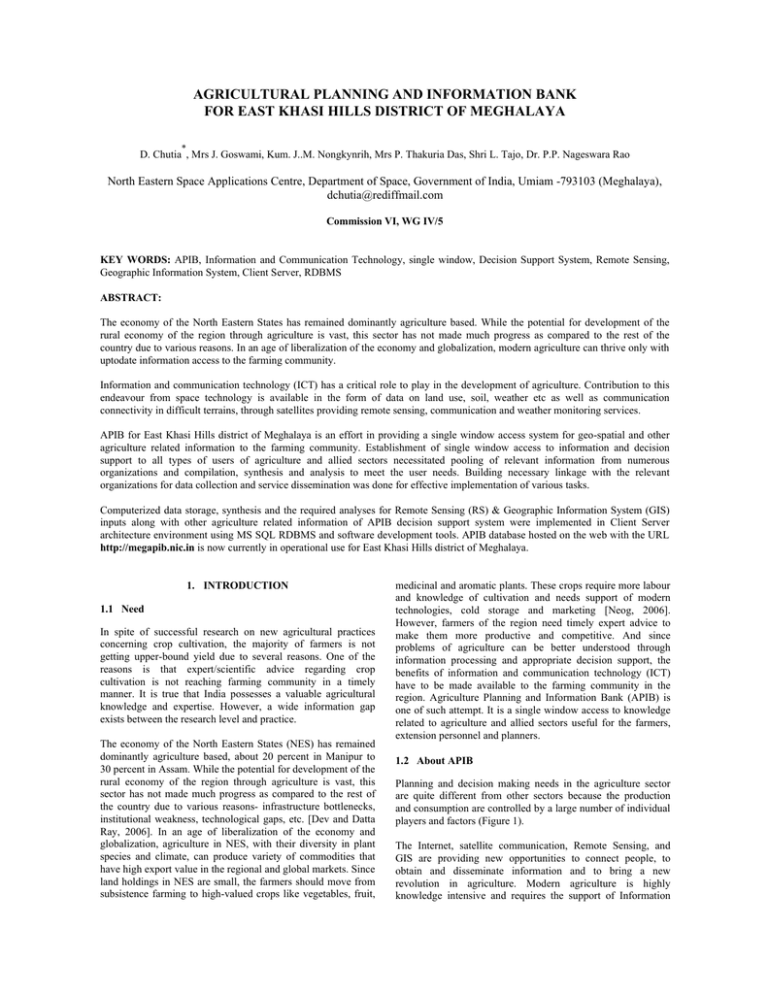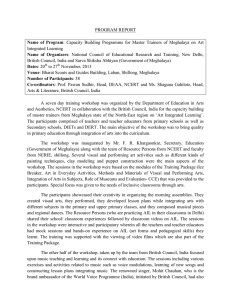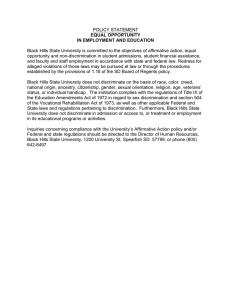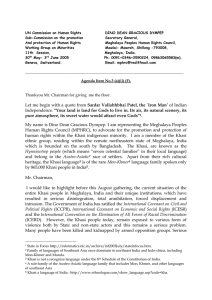AGRICULTURAL PLANNING AND INFORMATION BANK
advertisement

AGRICULTURAL PLANNING AND INFORMATION BANK FOR EAST KHASI HILLS DISTRICT OF MEGHALAYA * D. Chutia , Mrs J. Goswami, Kum. J..M. Nongkynrih, Mrs P. Thakuria Das, Shri L. Tajo, Dr. P.P. Nageswara Rao North Eastern Space Applications Centre, Department of Space, Government of India, Umiam -793103 (Meghalaya), dchutia@rediffmail.com Commission VI, WG IV/5 KEY WORDS: APIB, Information and Communication Technology, single window, Decision Support System, Remote Sensing, Geographic Information System, Client Server, RDBMS ABSTRACT: The economy of the North Eastern States has remained dominantly agriculture based. While the potential for development of the rural economy of the region through agriculture is vast, this sector has not made much progress as compared to the rest of the country due to various reasons. In an age of liberalization of the economy and globalization, modern agriculture can thrive only with uptodate information access to the farming community. Information and communication technology (ICT) has a critical role to play in the development of agriculture. Contribution to this endeavour from space technology is available in the form of data on land use, soil, weather etc as well as communication connectivity in difficult terrains, through satellites providing remote sensing, communication and weather monitoring services. APIB for East Khasi Hills district of Meghalaya is an effort in providing a single window access system for geo-spatial and other agriculture related information to the farming community. Establishment of single window access to information and decision support to all types of users of agriculture and allied sectors necessitated pooling of relevant information from numerous organizations and compilation, synthesis and analysis to meet the user needs. Building necessary linkage with the relevant organizations for data collection and service dissemination was done for effective implementation of various tasks. Computerized data storage, synthesis and the required analyses for Remote Sensing (RS) & Geographic Information System (GIS) inputs along with other agriculture related information of APIB decision support system were implemented in Client Server architecture environment using MS SQL RDBMS and software development tools. APIB database hosted on the web with the URL http://megapib.nic.in is now currently in operational use for East Khasi Hills district of Meghalaya. 1. INTRODUCTION 1.1 Need In spite of successful research on new agricultural practices concerning crop cultivation, the majority of farmers is not getting upper-bound yield due to several reasons. One of the reasons is that expert/scientific advice regarding crop cultivation is not reaching farming community in a timely manner. It is true that India possesses a valuable agricultural knowledge and expertise. However, a wide information gap exists between the research level and practice. The economy of the North Eastern States (NES) has remained dominantly agriculture based, about 20 percent in Manipur to 30 percent in Assam. While the potential for development of the rural economy of the region through agriculture is vast, this sector has not made much progress as compared to the rest of the country due to various reasons- infrastructure bottlenecks, institutional weakness, technological gaps, etc. [Dev and Datta Ray, 2006]. In an age of liberalization of the economy and globalization, agriculture in NES, with their diversity in plant species and climate, can produce variety of commodities that have high export value in the regional and global markets. Since land holdings in NES are small, the farmers should move from subsistence farming to high-valued crops like vegetables, fruit, medicinal and aromatic plants. These crops require more labour and knowledge of cultivation and needs support of modern technologies, cold storage and marketing [Neog, 2006]. However, farmers of the region need timely expert advice to make them more productive and competitive. And since problems of agriculture can be better understood through information processing and appropriate decision support, the benefits of information and communication technology (ICT) have to be made available to the farming community in the region. Agriculture Planning and Information Bank (APIB) is one of such attempt. It is a single window access to knowledge related to agriculture and allied sectors useful for the farmers, extension personnel and planners. 1.2 About APIB Planning and decision making needs in the agriculture sector are quite different from other sectors because the production and consumption are controlled by a large number of individual players and factors (Figure 1). The Internet, satellite communication, Remote Sensing, and GIS are providing new opportunities to connect people, to obtain and disseminate information and to bring a new revolution in agriculture. Modern agriculture is highly knowledge intensive and requires the support of Information and Communication Technologies (ICT). It is hoped that ICT can provide opportunities to reach the un-reached and provide livelihood to unemployed youth in the rural areas [Nageswara Rao, 2004 and 2006]. 2. STUDY AREA East Khasi Hills is one of the seven districts of the State of Meghalaya. The district occupies an area of 2748 Sq Km. and it lies between 25°07” & 25°41” N Latitude and 91°21” & 92°09” E Longitude. Bounded by Ri-Bhoi District on the north, Karbi Anglong District on the north east, Jaintia Hills district on the east, Bangladesh on the south and West Khasi Hills district on the west. Shillong is the district head quarter. 2.1 The Agriculture Scenario in East Khasi Hills district Figure 1. Factors that influence the farmers and the consumer in the agriculture ecosystem. A few experiments carried out in this direction give us confidence to put the ICT to use. For example the Agro Climatic Planning and Information Bank (APIB) that was developed by RRSSC-B/ISRO for a few districts in Karnataka, the virtual college established by M S Swaminathan Research Foundation (MSSRF) in the rural areas of Pondicherry, and the website of Indian Farmers Fertilizers Cooperative Ltd (IFFCO) are a few models that provide value-added information to the agriculture community [RRSSC, 2003]. The Agricultural Planning Information Bank (APIB) provides a single window access to data, information and knowledge base for all users of agriculture and allied sectors. In order to provide information access to rural areas using above- mentioned technologies, NESAC in collaboration with the Central Department of Agriculture and Cooperation and Government of Meghalaya has decided to set-up an Information Kiosk on lines similar to APIB for the East Khasi Hills district with a special emphasis on agriculture development. 1.3 Objectives of the project The basic goal of APIB is to develop a reliable, updated, relevant, easily accessible and readily available and affordable decision support system to the various user categories to meet their location-specific needs. The tasks that are to be achieved for this purpose are: 1. 2. 3. 4. 5. 6. Collection & compilation of agriculture related data and information. Database development in RDBMS & GIS environment. Integration of various data analysis, information retrieval and planning tools. Dissemination of information and planning services in appropriate formats to various users through easily accessible media. Arranging Training and Awareness Workshops for the farmers. Dissemination of agricultural advisory services in the local language (Khasi). East Khasi hills district is covered under the Agro-climatic Region Meghalaya-Mikir Region. A part of the district falls under the Temperate Sub-Alpine zone, and other part in the Mild Tropical Hill Zones. The climate of East Khasi Hills varies according to elevation and exposure. The Central Highlands with elevation of 1500 metres and above have a temperate climate; Places at lower elevations are warm and humid. Rainfall also varies from place to place. Places on the southern escarpment, facing the south-west monsoons (viz. PynurslaCherrapunji- Mawsynram) receive an average of over 900011000mm of rain annually. This region experiences a short water deficit of about 50-130mm during post monsoon. The soils of district are light to heavy in texture. They range from acidic to soils rich in organic matter but poor in phosphorous. Potash content varies from medium to high. Red soils are commonly found in the central and sub-montane regions while black and red loam occurs in the low lying hills. Agriculture is the main occupation of the people of the district. About 75% of the total population of the district live in the rural areas is mainly depending on agricultural activity for livelihood. Though, most of the population depends on agriculture, the total cropped area is only about 14.6% of the total geographical area of the district. The total cropped area is less which is due to a lot of constraints, such as the undulating topography transport and communication problem, population dispersal pattern, poor marketing system etc. Potato is grown extensively in the district. Around 11,322 ha area is under potato cultivation. Among the horticulture crops orange, banana, pineapple, arecanut, papaya, are also grown. The horticulture crop occupies about 10,354 ha area with production of 42,225 metric tones. Besides potato and horticulture crops rice, maize, sesamum, mustard, soybean, ginger, turmeric etc. are also grown in some areas of the district. The total cropped area is 40,139 ha of which only 7740 ha area is sown more than once. 2.2 Prioritization and choice of study area The wide variations in the soil-climatic conditions offer scope for the cultivation of a wide variety of agricultural and horticultural crops, ranging from species adapted to tropical to temperate climates. The spatial database on various thematic layers is already available for East Khasi Hills District which has been prepared under Natural Resource Database Management (NRDB) project. The district has been chosen based on availability of spatial database and also its unique agro climatic characteristics and diversity of agricultural practices. 3. METHODOLOGY The methodology proposed for realizing the objectives of the project involves the following steps: 1. 2. 3. 4. 5. 6. 7. Users’ needs assessment Organizational linkages Identification of spatial & non-spatial data sources and collection Analysis and synthesis of data Value edition to data to derive planning advises Database Development Plan for dissemination of services The various functions involved in the project and their linkages are depicted schematically in Figure 2. 3.2 Organizational Linkage Efficient collection of data from various organizations and disseminating the services to the user community through various media and organizations require building proper linkages with all the relevant organizations. This is a crucial function since both data collection and information dissemination requires active cooperation of relevant organisations in agriculture and allied sectors. As agriculture is a multi-disciplinary sector, a very large number and type of organisations both private and public, have to be involved. A knowledge base has been build with expertise from many quarters. The concerned specialists have been consulted to validate the authenticity of data before incorporating into the database. Sustained efforts from the beginning of the project have resulted in establishing good rapport with all the organizations involved in the task. Periodic meetings were held with the identified working groups in each of the organizations. 3.3 Data collection & Sources Creation of single window access to information needs of all users of agriculture and allied sectors implies collecting data from all relevant sources. Because of the multi-discipline nature of the activity and various types of stakeholders, from individuals to government and private organizations, the sources of data are quite numerous. APIB database has not only the conventional non-spatial data but also the latest, scientific spatial data on existing land use, land resource development plan, under ground water, soils, weather, etc. Thus, data has been categorized in two main heads i.e. spatial and non spatial data to meet the information requirements. Figure 2. Factors that influence the farmers and the consumer in the agriculture ecosystem. 3.1 User Needs Assessment Assessment of the needs of the farmers to transform agriculture and allied sectors as a vehicle of economic prosperity is the first step in this project. The task of this exercise is to find out the actual information needs of various types of users of agriculture and allied sectors. The specific objectives were: 1. To identify the nature of information required by farmers and extension officials. 2. To classify the information based on its nature, and 3. To identify the most effective channel for disseminating different types of information. Group meetings and rapid appraisal techniques have been adopted for the study to assess the user needs. The group discussions and interview through interpersonal contact were carried out with a ready made questionnaire. As per the directions of the Steering Committee, the working groups have facilitated discussions with the farmers and extension officers in representative four blocks of the district and based on their feed-back information need was categorized into different priority level. As a part of this project a separate report has been compiled on “Identification of User Needs for Setting up APIB in the East Khasi Hills District of Meghalaya” [NESAC-SR-312004]. 3.4 Database Development and Structure In order to facilitate efficient processing and retrieval, computerized storage becomes essential. The data is stored in the database after proper structuring and formatting. Database enables data processing by facilitating orderly and instantaneous retrieval of the required data. By itself, the database is meaningless and worthless. Information is the data that has been processed into a form that is meaningful to the recipient and is of real or perceived value in decision making. Information to one person could be data to another person, who has to process it for some other purpose. On the other hand knowledge is contextually processed information. That is why, information that is appropriate to a particular context become the knowledge base. A decision support system that incorporates a knowledge base is called an ‘Expert System’. The aim of expert system is to bring expertise to non expert users. The latest techniques such as data mining can be used to extract the possible meaningful patterns for a large amount of data that could give potential useful advice depending on the situation. Also, modeling and simulation technology can be used to model an ideal crop situation and predict the crop growth through extrapolation and other techniques by considering a specific crop environment. In a multidisciplinary field like agriculture, the extension officials at the grass root levels feel the need for an expert system. In the APIB system, the expertise has been obtained from expert scientists of concern state and central government departments. This expertise has been incorporated for formulating various decision making rules. 3.4.1 Information Modules Entire APIB system is categorized into various modules (Figure 3) as per their information content. Specific information can be accessible from a single module alone or combination of modules if required. Information modules of APIB are categorized broadly under three main classes of information: 1. Natural Resource Information 2. Planning Services and 3. Allied Sectors & Occupation 4. Others Figure 4. Information Dissemination Network for APIB 4. IMPLEMENATION Database has been generated to facilitate organizing, storing and processing to meet the information and decision support needs of various users. Agriculture Planning and Information Bank (APIB) has to function in a multi-user environment. 4.1 Client Server Architecture Figure 3. Category wise various modules of APIB 3.5 Dissemination of Services Client Server architecture (Figure 5) has been adopted for APIB System, because it is a repository of multiple heterogeneous data sources (various spatial and non-spatial data), organized under a unified schema at a single site (single window access) in order to facilitate management decision at many places by many people. An important component of such an APIB is that it should provide day-to-day advice on market and weather using the terminology that farmers use and understand. The need of this exercise is to supply information in local language. No single system of communication, however strong it may be, can reach the entire agricultural community in the hilly terrain. The telecommunications infrastructure is now very widespread, and reaches quite extensively into the countryside. Satellites are being used for data collection, and also for communication, thereby providing wide reach and access. Training and developmental Communication Channel (TDCC), North Eastern Region established at NESAC, Shillong, Wireless in local loop(WLL) transportable V-SAT system of NESAC, Shillong could be used for disseminating services in remote areas. While Internet is the primary mode of communication, the APIB will also use media such as community radio (terrestrial and satellite) and cable television, besides print media (community newspapers) based on specific requirements. As a first option, we opted for using Internet for APIB data dissemination services because information can be shared to a large section of users simultaneously, it is easily available, affordable, and easy to update and manage. Website has been designed and developed for APIB database and hosted on the web through NIC web Server. Figure 5. Three Tier Client-Server Architecture for APIB 4.2 Database Creation Database part is divided into two distinct parts. The first part involves in the creation of spatial database using Remote Sensing and GIS techniques. Relational Database Management System (RDBM) based database have been designed and developed for various modules under non-spatial category. Database has been created under Client-Server environment. MS SQL Server was used as a database server and Visual.NET has been used as a front-end tool. Query-based information retrieval facility also has been incorporated in the database system. 4. incorporated into the system for online decision making support on GIS data. ArcIMS (Internet Map Server) and ArcSDE (Spatial Database Engine) can be used to develop dynamic web pages of thematic maps. 4.3 Web Deployment 4.5 References APIB has been proposed to put in the Internet so that essential information is easily available to the large section of users. Hence, APIB may be treated as a Web-based single window access system which can be accessed either locally in the Intranet or information can be accessed through internet. User feed backs on information contents; suggestions regarding further improvement of the site or its content are easily available to the web master of APIB. Server has been configured with Internet Information System (IIS) to work as a Web-Server and MS SQL Server and Visual Studio.Net are configured over IIS for database development and database management. IIS is a software service that support Web site creation, configuration, and management, along with other Internet functions. APIB Site has been registered under National Informatics Centre (NIC) domain (NIC.IN) and the site is available in the internet with the URL http://megapib.nic.in. Deb, B.J. and Datta Ray, B. (Eds) 2006. Changing Agriculture Scenario in North East India, Concept publishing Company, New Delhi. Elmasri, R. and B. Navathe, S. (Eds). Fundaments of Database Systems. Pearson Education. Han, J. and Kaber, M. (Eds). Data Mining Concepts and Techniques. Mongan Kaufmann Publishers. Huay Xuan, N. (Ed). Software Engineering. Institute of Information Technology, National Center for Natural Science and Technology. Nageswara Rao, P.P. 2006. APIB: A Social Enterprise for the Unemployed in NER. In: Changing Agriculture Scenario in North East India, (Ed) Deb, B.J. and Dutta Ray, B. Concept publishing Company, New Delhi. Nageswara Rao, P.P. 2006. APIB: Information Services to the Farmers. Information for Development. Vol 11(7): 1617. National Informatics Centre (NIC), Meghalaya State Centre. Neog, A.K. 2006. WTO and agriculture development in backward regions. In: Changing Agriculture Scenario in North East India, (Ed) Deb, B.J. and Dutta Ray, B. Concept publishing Company, New Delhi. Reddy, P. Krishna 2004. A Framework of Information Technology Based Agriculture. In: Proceedings of 22nd Annual Conference of Andhra Pradesh Economic Association, 2004, D.N.R. College, Bhimavaram, 14-15, Februaray 2004. Figure 5. Natural Resource Information Module in the web browser RRSSC (Regional Remote Sensing Service Centre), 2003. Agro-climatic Planning and Information Bank (APIB). (ISRO-RRSSCB-TR-105-2003). 4.4 Guidelines for Continuation The basic framework for a complete web enabled APIB decision support system has been carried out during this project. Since, modular approach for spatial and non-spatial information of APIB has been adopted during the development, maintenance is much easier. Provision is kept in the system for adding new features or functionalities in later course of time. Some aspects of such are as follows: 1. 2. 3. System has been developed for one district of Meghalaya now, but it can be extended to work for other districts of Meghalaya. The entire system can be developed using MS.NET platform to enhance more functionality and security. More GIS functionalities such as proximity analysis, network analysis, and spatial analysis can be 4.6 Further Information If you want further information about APIB, please contact the following authors. D. Chutia, NESAC, Umiam-793103, dchutia@rediffmail.com Mrs J. Goswami, Kum, NESAC, Umiam-793103, goswamijonali@rediffmail.com J..M. Nongkynrih, NESAC, Umiam-793103 Mrs P. Thakuria Das, NESAC, Umiam-793103 Shri L. Tajo, NESAC, Umiam-793103 Dr. P.P. Nageswara Rao, NESAC, Umiam-793103, megapib@shillong.meg.nic.in





